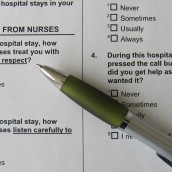Ebola — this word has its own hashtag, millions of tweets, hundreds if not thousands of articles in the past month, and the power to frighten many people. Fear is playing a large role in how this disease is perceived, which is a poor foundation for managing its spread. Communicating Key Information Electronic health records (EHR) are essential tools in clinical care. When written words in an electronic record become the primary way information is shared among busy clinical staff, I believe we inject increased risk into clinical care. The nation is following the Dallas case almost minute … [Read more...]
HCAHPS… Not Like Amazon!
You understand the limitations of the HCAHPS survey if you work in a hospital today. Whether a busy clinician or clinical leader, you will appreciate having access to a new study about the limitation of quantitative measures alone in analysis of patients’ experience with their hospital care. Two take-a-ways from this study Patient comments enhanced the numerical results of the survey Patients who provided negative comments gave significantly lower numerical scores The Journal of Healthcare Management recent article gives credibility to the importance of qualitative feedback from … [Read more...]
Engaging Patients: Back to the Future
One thing is clear in the chorus of words about patient care today, there is no consensus on a definition for patient engagement. I suggest we are missing something very important because we have a historical precedent for patient involvement in their care that led to positive change. In fact it was patients who became a very powerful force for change because they read, they attended classes and they understood they should be partners in the way they received care. They were engaged. In the 1970s, childbirth education surfaced to help women learn about the normal processes of labor and … [Read more...]
3 Simple Measures to Reduce Medication Errors
In the last post I asked if “engaged patients” was a buzz-word or a reality given the differing ways people interpret the term engaged. If we believe that “engaging patients” means to actively listen to understand the patient’s needs, we are on a path to partnership with patients and families. Active listening opens the door to meaningful two-way communication. The added bonus of tuning-in for a couple of minutes is that patients sense a higher level of interest from the nurse and doctor. And this is your direct connection to managing HACAPS. HACAPS will never be a true measure of clinical … [Read more...]
What Do Our Patients Know About Their Hospital Care?
If you are a nurse or doctor and practice in a hospital today you understand the feeling of being on a fast train that has gone out of control. You and your patients are living in a rapidly changing environment, and the end point for this very fast ride is an unknown. Yet, you practice to achieve best outcomes for your patients, perhaps with variable resource and staffing. But, if the numbers (those measurements of outcome, satisfaction and other factors) are not in the ballpark, everyone suffers because money is lost to the hospital in which you practice. In a recent post for Forbes … [Read more...]
Patients and Black Holes
Patients fall into endless space everyday….Black Holes are the side effect of modern healthcare. In the early 20th century Black Holes in outer space were seen as a phenomena where matter was absorbed and nothing could escape. If you, a loved one, or even an employee has ever had to deal with a health issue that requires coordination between various professionals it is likely you understand the Black Hole analogy all too well. A recent Washington Post article, “Many doctors, too little communication”,hits on a key factor creating Black Holes, the lack of care coordination. It … [Read more...]
Influencing Change in Today’s Hospital Care
Although regulators and payers influence many of the actions surrounding patient care, particularly in the hospital, the unadvertised and underused driving force for positive change comes from these important groups: These groups are . . . Patients & Families Clinicians Employers Their power comes from shared goals. (1)They want to achieve good outcomes from the care that is rendered. (2) They seek to prevent harm and (3) control unnecessary costs that are associated with medical mistakes, such as healthcare acquired infections. This is called “patient-centric” care. … [Read more...]



